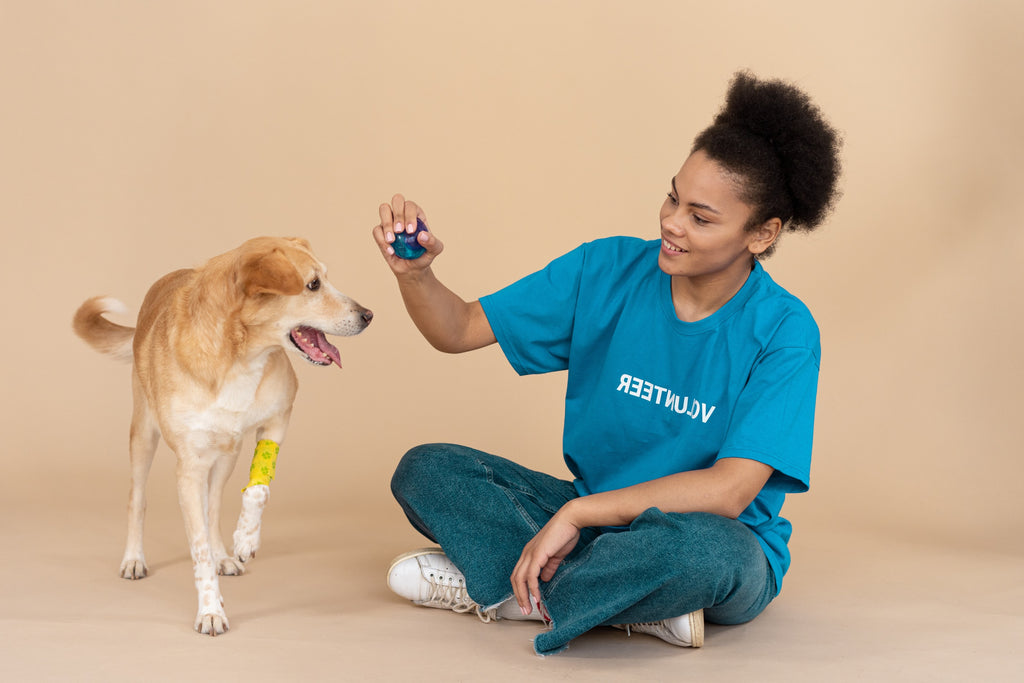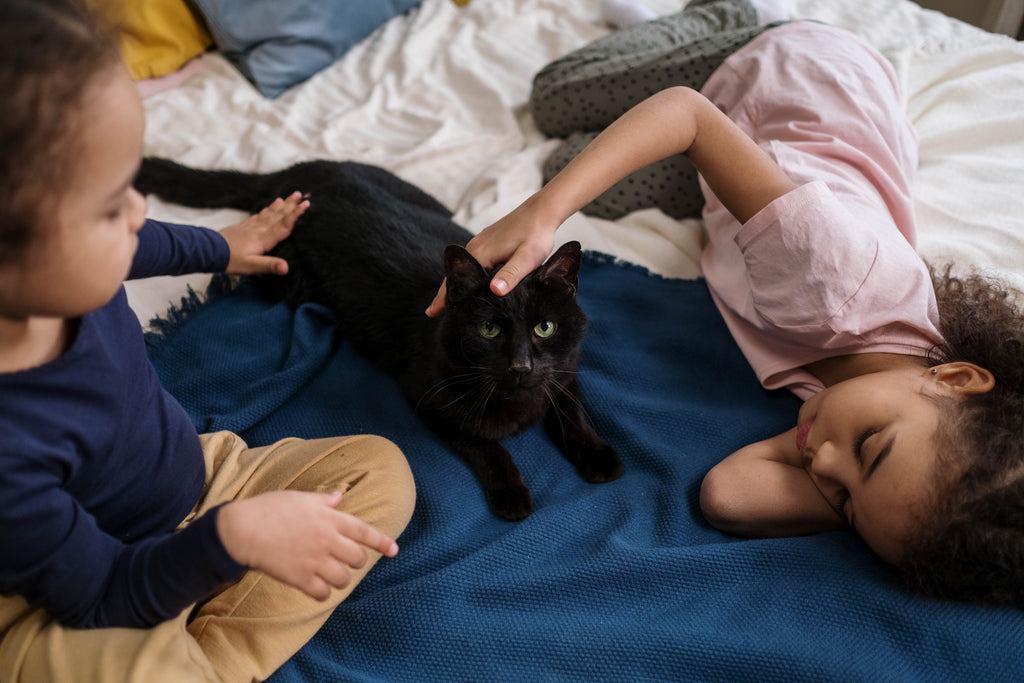Pet Assisted Programs - You Will Cry Reading This Article!
Let’s fly away for a moment together and spy into the life of Jeremy. He’s 6 years old, he has red hair and freckles and the most endearing smile you have ever seen. Oh yeah and one more thing…he has cancer.
Every week he goes to the hospital with his mom for treatments. After 3 surgeries the prognosis is still not good. Yet, through it all, you can’t pass by this little boy without a smile on your face and warmth in your heart.
A therapy animal can do wonders for your physical and mental health!
Today Jeremy is very tired and his smile has lost its brilliance. He cries as his mom brings him to the hospital. It’s, to say the least, a bad day for Jeremy. Today he doesn’t smile or cooperate. The nurses and doctors struggle with him and his mom can only hold back her tears at the scene.
All of a sudden, Jeremy is still and his eyes start to sparkle. He just spotted Rover walking in! Arms extended Jeremy soon gets a big hug and kiss from his furry friend. Rover has helped Jeremy before in those rough moments and here he is back again and will faithfully stay by Jeremy until the treatment and tests are over.
The results of animal assisted therapy sessions are just amazing
Believe it or not, this is already dog assisted therapy in action! Rover isn’t Jeremy’s dog and it’s not just any animal that is allowed in the hospital. But thanks to established programs like zoo/pet therapy and animal-assisted therapy, this little boy was able to make it through the day with a smile back on his face.
Therapy Animals: A Magical Combination

If you are one of those people who cannot pass by a pet store without stopping and saying hello to the playing puppies or kittens in the window, then you are living proof of the effects animals have on us. Animal assisted therapy works on the same basic principles of natural human animal bond. It uses the laws of nature to the advantage of those who are suffering.
Beyond simple nature, those who establish these programs also put in long hours of effort and research to match the perfect animal to every human or home in need. Of course, we are not saying that a dog, rabbit, or cat will make the whole world healthy again.
A systematic review of therapeutic intervention with animals involved
However, reports prove that in 91% of animal-assisted cases, there have been marked improvements in both mental and physical conditions. For over 30 years now more and more people have become aware of the rare and beautiful opportunity to share hope, love, and joy with ill and isolated people with their pets.
You may even want to take part in these programs yourself with your friendly pet. Why? Let’s have a look at the reasons.
Why is AAT (Animal Assisted Therapy) So Amazing?

Let’s suppose you do decide to participate in a pet therapy program. Excellent! Here we go… Today your dog is groomed, ready, and eager to meet new people. Your first patients await you in a nearby home for the elderly.
It’s hard to imagine what to expect for the first meeting between strangers, but your dog trails on forward without looking back. He moves in close to the first person sitting in the living room watching TV rather uninterested. Just one nudge of the nose on her hand and she turns to greet her new friend with a pat on the head and a "why, hello there!"
One after another your dog formally greets everyone with a wet-nosed nudge or simply lays his head on their lap. You can see magic in the air fill this lifeless room. A smile of happiness and satisfaction automatically creeps to your lips. The smile is completely uncontrollable; you’ve just witnessed nothing short of a miracle!
It is not just for post-traumatic stress disorder
Animal assisted therapy (AAT) programs mean just that! Making miracles happen. Why can we say this? Not only do people benefit from happy companionship but also they are helped in areas of socialization (such as in cases of post-traumatic stress disorder), healing (like in the case of lowering blood pressure), and even rehabilitation (such as in patients recovering from brain injury)!
It is true that these kinds of improvements or results are hard to measure since the highest benefits are purely emotional or psychological. Yet anyone participating in such programs will tell you, the results are real! For example, let's look at why pet-assisted therapy works in the following surprising cases:
Autism spectrum disorder and attention deficit hyperactivity disorder (ADHD)
A therapy dog is often used in this case to help promote healthy social interaction. Children with autism spectrum disorder benefit so much from animal assisted activities. Studies conducted by mental health professionals show that they become more talkative, less aggressive, and smile more with these programs!
This for sure helps ease the burden on the family and everyone is happier. Animal interactions also help curb (or even do away with) behavioral disorders that are typically associated with autism as well as attention deficit hyperactivity disorder (ADHD).
Epilepsy
Alert dogs are so special for patients suffering from epilepsy. Some therapy dogs can determine when a seizure is coming a few minutes before it hits and alert others to it. Also, these service dogs protect the patient before and during the seizure from injury, staying faithfully by their side during the process.
According to a randomized controlled study, they effectively bring companionship and emotional support to these special patients. Animal assisted activity also provides a therapeutic setting while establishing positive relationships and social support at the same time. Dog assisted therapy is one of the complementary therapies available for this condition. Research suggests that this could be applicable to those who've had brain injury, too.
Alzheimer’s
Unfortunately for millions around the world, old age comes with dementia or eventual Alzheimer’s. It is a gradual and unpredictable state in which caretakers have a hard time helping them without taking away their independence.
Trained dogs can help lift a big load during this time. They are trained to guide their "human" home if he or she doesn’t remember how to get back. Also, they are trained in a routine, so they help the patient through their daily routine and motor skills in case they forget to wash or eat.
Besides stimulating positive emotions and higher self-esteem, service dogs help them feel secure and independent, not to mention they always have a friendly companion. While further research is needed, motor skills can be improved as well. Canine assisted therapy is also seen to have benefits with respect to other types of mental health problems based on randomized controlled trials.
Terminal patients
As we’ve seen in the introduction to this article. So many around the world become seriously ill and for many, unfortunately, there is little to no hope of recovery. Animals cannot heal them or make them much better physically.
Yet, so much can be done emotionally to help them through rough hours or treatments. Also, they greatly benefit against depression (and other issues concerning mental health care) with companionship and a wonderful listening ear! These are just a few of the cases animals are such wonderful assets to therapy.
Sure, not everyone can be part of these programs, but for those who can (even in some small way), the experiences fill the heart with tender warmth and fulfillment. In participating you can provide comfort, lift spirits, lower anxiety, lower physical pain, and also bring motivation to those who lose their own strengths during personal hardships and sickness.
This, of course, is only a very short list of benefits, all of which come from joining a great program for those who need it most.
Are There Any Risks Involved With Animal Assisted Therapy?

Just to be very transparent, animal assisted therapy does have a few risks that you should know about. We made it a point to include them here since there is a very small possibility that these issues could get in the picture when you're working with therapy animals.
On the other hand, these risks won't manifest if both the handler and therapy animal have been thoroughly informed, trained, and updated as regards how the therapeutic activities should be conducted.
These specifically cover how to deal with a child's behavior with respect to the pediatric population or institutionalized elderly in other facilities. Illness perception among senior patients has also been seen to improve.
We'd like to stress as early as now that we have dedicated a specific section of this blog post for this possible issue. We'll go over them in just a bit.
A therapy animal may cause a lot of distractions
One of the biggest goals of animal assisted therapy is to make the most of human animal bonds in promoting improved outcomes with regard to how people cope with a particular condition or disease. Some participants in assisted therapy sessions may get too distracted by the various animals involved. Case in point: therapeutic horseback riding, which can disrupt the conduct of pain relief intervention.
As a complementary treatment, they may get too focused on a therapy dog, cat, or rabbit. This might get them too preoccupied with respect to the main mode of treatment in a hospital setting or some other clinical practice. Some animal assisted therapy participants may even get too excited or lose self-control when encountering these pets during their therapy sessions.
Some people are afraid of certain animals
It's not uncommon that there are people who are not that into animals, even to the point of being scared of them. Whether it's a service dog or a therapy cat, there will be persons who will feel uneasy or afraid when they interact with these animal companions.
This is a key factor why there should be proper planning and coordination prior to holding social interactions with therapy animals. Whether you're dealing with children, the elderly, trauma survivors, or military veterans, keeping this in mind is really crucial.
Allergic reactions are possible
While animal assisted therapy is primarily focused on maximizing the health benefits it can provide, there is a small chance that the participants could be prone to allergic reactions while at it. There are individuals who are allergic to the saliva, dander, or fur of therapy dogs and other pets involved in animal assisted therapies.
Hygiene issues
If we're being honest, there might be untoward incidents concerning hygiene that could happen during social interactions with animal assisted therapy participants, especially in a hospital setting. Again, we'd like to emphasize the importance of proper planning and coordination prior to holding social interactions with therapy animals.
Cultural and ethical factors
Apart from personal preferences, cultural and ethical factors must also be considered before conducting animal assisted therapies. There are some people whose beliefs may restrict their social interaction with animals and may even prevent them from getting the health benefits associated with animal assisted interventions. Some people going through mental health conditions may also have inhibitions about interacting with a service dog.
Now we've got that covered, we'd like to add that there is a rigorous process before you and your pet can be considered as members of an animal assisted therapy team. There are tests for your pet that should be passed and other requirements that must be satisfied. This is how challenging the whole thing is. It just goes to show that the risks mentioned above only rarely happen.
Who Can Join Animal Assisted Therapies?
The real question is who wouldn’t want to be a part of animal assisted therapy? I’m sure if we could, we would all cuddle our pets and bring them to the closest residence or hospital we could find. But the reality is there is a lot to consider before making that step.
Animal assisted therapy is more than just bringing your canine or feline companion to a clinic or health care facility. There are certain guidelines that should be met so your animal therapy sessions will be as successful and productive as possible. How about we check them out now? By the way, the first few factors refer to you and not your pet.
Crucial factors to consider before getting in on animal assisted therapy sessions
First things first, make an honest self-evaluation. That’s right. You, the pet parent, have a big role to play in this as well. Animal assisted therapy has nothing to do with getting high scores or winning a contest. What you need to know is if you can handle the situations you would be faced with:
-
Can you handle funky smells or being around sick patients in discomfort?
-
Are you willing and able to follow the rules set by the program of the health care facility and health professionals?
-
Are you willing to improve your socialization skills?
-
How much time would you be able to set aside for visits? 1 visit a week? 1 visit a month?
-
Would your pet really enjoy this or are you doing this for you?
-
Are you willing to improve your communication skills?
-
Are you willing to go the extra mile in certain situations?
-
Are you willing to spend extra money to become a new member?
-
Can you afford that as well as the other things involved like gas and vet visits?
-
Are you willing to learn more about human health, particularly when dealing with certain health issues?
If you answer "yes" to these questions, you’re already headed in the right direction!
Now we've got that part covered...
It’s time to have a look at your pet that will participate in the animal assisted therapy session. As you can imagine, not every pet is suited for this kind of work. They all have different personalities and just maybe they don’t share your views on visiting strangers. Here are a few useful questions to evaluate your pet:
-
Does he/she have good manners? Even around new people?
-
Does your pet have good social skills, particularly among health professionals?
-
Is he/she at least 1 year old?
-
Did your pet have obedience training?
-
Does he/she have a clean bill of health and up-to-date rabies shots?
-
Does your pet like to travel?
-
Are you sure your pet won’t mind being excessively petted, hugged, or even tugged by kids or adults?
The requirements may vary for therapy animals
All pet therapy organizations have different requirements to join their teams, so the best thing would be to do your homework. Do they require some sort of course before joining? Would you have to travel far to make visits? What kind of facilities would you be visiting? Some places that provide mental health services may also have particular guidelines that should be observed.
These and all the above questions are IMPORTANT to analyze seriously! After all, this is not a program just for those who want to have fun showing off their pet. This is serious. You may be assigned to help people with mental health conditions and similar issues. Would it be fair that you spend a lot of time and even money only to find out this is not for you after one visit?
Be An Active Part of Change with Animal-Assisted Intervention
Millions of lives each year are touched by happy visits from new friends such as dogs, cats, horses, guinea pigs, rabbits and so many more. Are you and your pet the perfect pair to join into a smile-generating program? Excellent! Here are a few steps to get ready for:
Enlist your pet in an animal therapy program
You must check out the local registration and certification process and requirements. Before getting started, it’s good to know your pet is a match for this work. As we’ve mentioned, good manners and social skills are essential.
For example, your dog can’t bark at people, run toward them, or jump on them! Dogs, in this atmosphere, have to stay calm, and relaxed despite noises or smells. All-in-all, make sure you and your dog meet the requirements for this work before going any further in the process.
Service animals need a capable handler (and that's you!)
There will usually be an online or workshop "course" to complete as a pet handler. Here you will learn how to make sure you, your pet, and the visited stay safe at all times. Also, if unexpected events pop up (and they will happen, mind you) you'll be prepared to calmly deal with them.
Every organization has its own procedures as far as visits, so you will also have to learn how they, over the years, find the best way to go about making visits. Assisted therapy can also be different for various health professionals. How people cope with their condition can also vary.
An animal assisted intervention has to be as smooth as possible
Make sure all is in order. It’s important not to rush the process or skip steps. Make sure you understand and are able to follow through on the information received during the training. Also, now is a good time to make sure your pet is ready. Pay a visit to the vet to make sure all is in order and up to date. Now you’re ready to proceed to the next step.
Therapy animals need to go through an exam
Last and final step! Are you ready to pass the test and start a whole new and rewarding chapter in your life? Here we go! Generally speaking, pet-assisted programs want to make sure you and your pet are ready.
They will set the scene and see how well you handle your pet and how he responds in different situations. This is a very important exam. It will help them determine where you will be suited to make visits but also ensure everyone’s safety. Your animal companion must also always display self-control.
What a thrill it is to make the necessary steps and changes to experience personally the beauty that is zootherapy! Just imagine getting your first assigned visit! How exciting! If you are not 100% convinced this will flood you with rich blessings, read on!
Programs That Change Lives
Writing this article has given me the opportunity to come into contact with several AAT organizations and I must say they are inspirational and moving. They spend so much time and resources to help their communities in the very best way they know how. Here is a story that I had to share with you from Therapy Dogs Inc.:
‘There are thousands of stories! Anyone who does this type of volunteer work has a book full if they do it for very many years. I’ve done this for 24 years so I have several, but my favorite person who I visited for 8 years at a nursing home was a madam from a brothel in Wyoming.
Her name was Fairy Walker and the first time I met her she was 88 yrs. Old with a red dress, red heels, red hat and red lipstick. She looked at me and asked me, “Why do you have my dog?” I was so surprised at her question that I just answered, “I’m taking care of her for you?” To which she asked, “Is she eating?” “Yes, she’s doing very well.” I told her. Every month we went to see her and she talked to Eleanor, my Doberman, all the way around the facility. Sometimes I heard nothing but swearing so Elea got an ear full! She eventually had red high top tennis shoes instead of heels and they took her lipstick away because she wanted everyone to wear it. She died at 96 and I still miss her and her Doberman that was really mine.’"
So what do you say? Would your cat, dog, rabbit, guinea pig, horse, etc., work well in this type of program? Take it directly from Billie at Therapy Dogs Inc., who says:
“It’s the best thing you can do with your dog/pet. It’s a win win for all involved. I always say, “If you don’t do it, you don’t get it.” The rewards are priceless!”
So go ahead! Don’t be shy to ask your local veterinarians or clinics if they have pet-assisted therapy programs. If not, here are a few websites to help you start a brand new adventure with your pet.
Useful Links With Regard To Animal Assisted Interventions
USA-Pet-Assisted Therapy Programs
-
http://luxury.rehabs.com/experiential-therapy/animal-assisted/
-
http://www.americanhumane.org/interaction/programs/animal-assisted-therapy/
CANADA-Pet-Assisted Therapy Programs
UK-Pet-Assisted Therapy Programs
-
http://www.scas.org.uk/animal-assisted-interventions/accreditation-and-qualifications/
-
http://www.programsforelderly.com/nursing-pets-as-therapy-united-kingdom.php
SCOTLAND-Pet-Assisted Therapy Programs
INTERNATIONAL-Pet-Assisted Therapy Programs
Happy Endings
Whether helping a young boy get through a tough day, making a room full of elderly people lively again, or comforting a terminal patient in the last hours, ALL are priceless gifts. From large horses to small guinea pigs, every animal that participates in animal-assisted programs can make remarkable changes in the lives of those trapped in their own circumstances.
Let us cherish our beautiful pets and the power of change they can bring to our lives and the lives of others. We may not be able to change the world, but with them, we can change a frown into a smile every time.
If you have had cherished experiences with zootherapy or emotional support animals, please feel free to share your stories with us by leaving us a comment below. We always love to hear happy stories from animal lovers everywhere around the world.








LOVED cat
Leave a comment